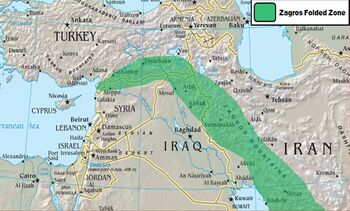Barada River
| Author:Laxman Burdak, IFS (Retd.) |

Barada River (Arabic: بردى / ALA-LC: Baradá; Greek: Chrysorrhoas) is the main river of Damascus, the capital city of Syria.
Origin of name
"Barada" is thought to derive from the word barid, which means "cold" in Arabic. The ancient Greek name means "golden stream".
Location
Throughout the arid plateau region east of Damascus, oases, streams, and a few minor rivers that empty into swamps and small lakes provide water for local irrigation. Most important of these is the Barada, a river that rises in the Anti-Lebanon Mountains and disappears into the desert. The Barada flows out of the Karst spring of ‘Ayn Fījah (عين فيجة), about 27 km north west of Damascus in the Anti-Lebanon Mountains, but its true source is Lake Barada, a small lake that is also a Karst spring located about 8 km from Zabadani.
Course
The Barada descends through a steep, narrow gorge named "Rabwe" before it arrives at Damascus, where it divides into seven branches that irrigate the Al Ghutah Oasis(الغوطة), site of Damascus. Eventually the Ghouta reached a size of 370 square kilometers, although in the 1980's, urban growth started replacing agricultural use with housing and industry. [1]
The river has also suffered from severe drought in the last decades, mainly due to the lower rainfall rates and the large increase in the population in the region. It also suffers from serious pollution problems, especially in the summer, where there is almost no flow and little water in the basin.
Biblical mention
Barada is identified as Abana (or Amanah, in Qere and Ketiv variation in tanach and classical Chrysorrhoas) which is the more important of the two rivers of Damascus, Syria and was mentioned in the Book of Kings (2 Kings 5:12). As the Barada rises in the Anti-Libanus, and escapes from the mountains through a narrow gorge, its waters debouch fan-like, in canals or rivers, the name of one of which, the Banias river, retains a trace of Abana. [2]
John MacGregor, who gives a description of them in his book Rob Roy on the Jordan, affirmed that as a work of hydraulic engineering, the system and construction of the canals, by which the Abana and Pharpar were used for irrigation, might be considered as one of the most complete and extensive in the world. In the Bible, Naaman exclaims that the Abana and Pharpar are greater than all the waters of Israel. [3]
References
- ↑ Collelo, Thomas, ed. (1988). "Land, Water, and Climate". Syria: a country study. Federal Research Division, Library of Congress. LCCN 87600488
- ↑ Chisholm, Hugh, ed. (1911). "Abana". Encyclopædia Britannica 1 (11th ed.). Cambridge University Press. p. 6.
- ↑ Chisholm, Hugh, ed. (1911). "Abana". Encyclopædia Britannica 1 (11th ed.). Cambridge University Press. p. 6.
Back to Rivers

